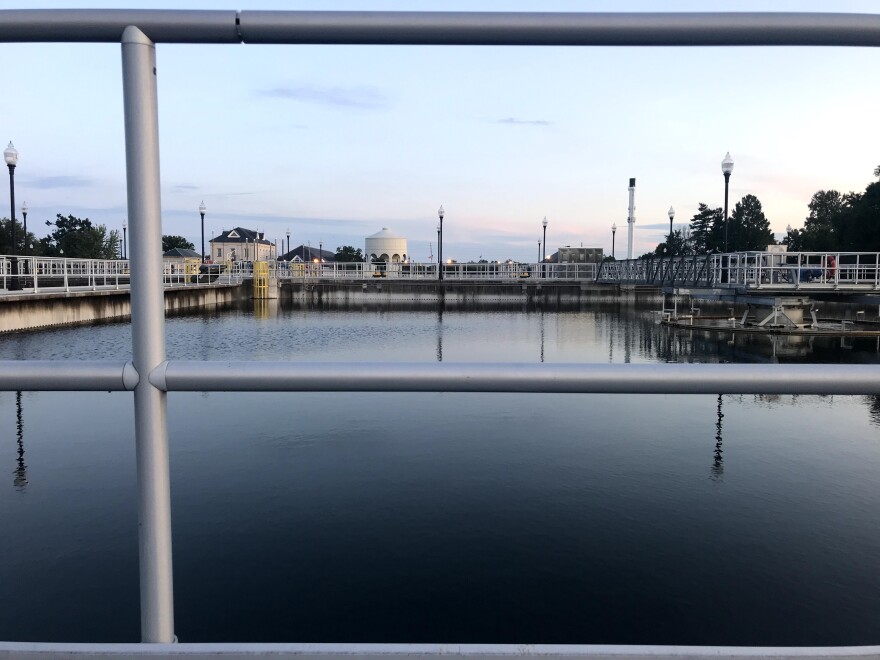The city of Lewisport, Kentucky, is a seven-time winner of the Best Tasting Water in Kentucky. This spring, city leaders discovered another top ranking of its water, but one they would be loath to promote.
The Kentucky Division of Water collected samples from the Lewisport water plant as part of the latest round of statewide testing for forever chemicals. The city’s drinking water tested positive for three compounds among the tens of thousands that belong to the family of chemicals, also known as per-and polyfluoroalkyl substances (PFAS).
Forever chemicals are used for all sorts of stuff: non-stick cookware, stain-resistant carpets and waterproof clothing. They’re now present in Kentucky’s soil, water, air and in fish tissue. And they’ve been linked to cancer and several other health problems — even in small quantities.
Over the last five years, Kentucky’s Department for Environmental Protection (DEP) has tested 91% of the state’s water treatment plants for PFAS, according to an LPM analysis.
They’ve found detectable levels of forever chemicals in the drinking water at 44% of the water treatment plants they tested -- 86 plants in total.
In the latest round of data from 2023, the state found two places with PFAS levels above proposed federal standards, or maximum contaminant levels.
- Lewisport’s drinking water showed levels of PFOS three times higher than proposed standards.
- Marshall County’s North Marshall Water District showed levels of PFOA nearly three times higher than proposed standards.
DEP Commissioner Tony Hatton has been the architect for the initiative since its inception. He helped to set up a state lab where researchers could conduct their own testing.
“We didn't collect the data for the sake of collecting data. We have started using that data to go to where we see specific issues, and start assisting, trying to get ahead of it,” Hatton said.
The state’s first round of testing in 2019 found PFAS chemicals in about half the drinking water systems in Kentucky including Louisville. Researchers discovered the highest levels in South Shore, Kentucky, which has since switched its water source as an interim fix and is finalizing a long term solution, Hatton said.
The Department for Environmental Protection is now working with the communities of Lewisport and Marshall County to find their own remedies.
A nationwide problem
Forever chemicals have been discovered in more than 3,000 locations across all 50 states, according to Environmental Working Group data from August. Kentucky Rural Water Association Director Scott Young agrees.
“PFAS is something that every water utility and community is going to have to at some point, address or deal with, whether they have it or not,” he said. “From a consumer standpoint, they need to know what's in the water, they need to know what's being done to address it.”

At this point, there are basically two remedies for treating water, reverse osmosis and granular activated carbon. They’re different ways of stripping water of unwanted particles. Neither are cheap, each has its own drawbacks and all of these costs are likely to be paid for by ratepayers and utilities that had nothing to do with the contamination, Young said.
“The public utility is at a significant disadvantage, because it's being tasked with cleaning up the drinking water supply from another industry,” he said. “And they're also being asked to do it at the expense of their customers.”
Rural water utilities with fewer customers and smaller tax bases are at a particular disadvantage.
The Biden administration announced $2 billion in grant funding in February to help rural communities address the problem, though experts say it’s only a fraction of what’s necessary.
Democratic Sen. Robin Webb of Grayson said the costs are going to be a problem, and part of the solution is to focus on the polluters, the companies that are releasing these chemicals.
“This is pretty important and it’s going into the water that these company CEOs and their stakeholders are drinking,” Webb said.
She thinks there is bipartisan support for a rational approach to notify people that these chemicals are in their drinking water, and to clean them up across the commonwealth.
Hatton, DEP commissioner, said the state is looking at sources of PFAS in the state.
“We’re trying to position ourselves for when regulations do come online. There’s going to be a large amount of issues that we have to address.”
Expensive solutions
A test in August confirmed the contamination in one of seven groundwater wells that Marshall County pulls from for its drinking water, said Roger Colburn, Manager for North Marshall Water District.
“We’ve got our theories about things, but don’t know until we do,” Colburn said. “We felt like the safe thing to do is just to turn it off.”

They took the well, and a water treatment plant out of service that serves about 650 customers in northern Marshall County. Now all of the community’s drinking water is coming from uncontaminated wells at another North Marshall treatment plant.
In June, the city of Lewisport approved spending to conduct a four-month pilot study using a reverse osmosis system to remove the chemicals. It cost $175,000.
They’re also looking at building a new water treatment plant at an estimated cost of $15 million.
“This pilot study was also intended to provide the Kentucky Division of Water with the information relative to reverse osmosis as a technology for potable drinking water production and provide the optimal operating conditions for a full-scale water treatment facility,” said Mayor Chad Gregory in an email to LPM.


